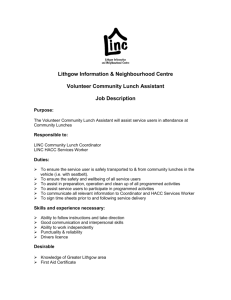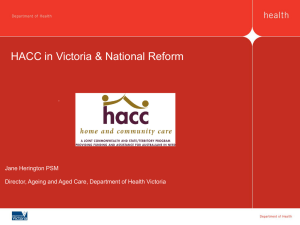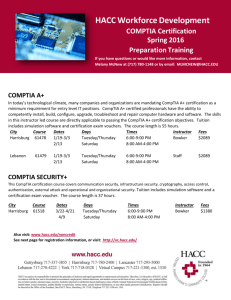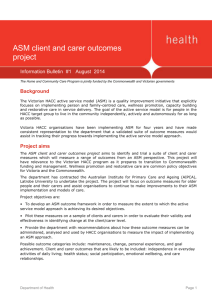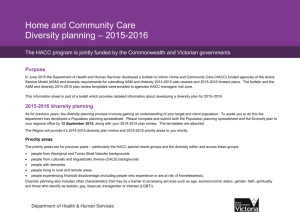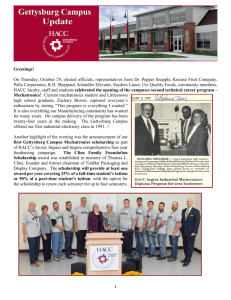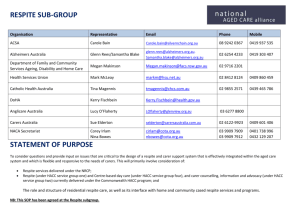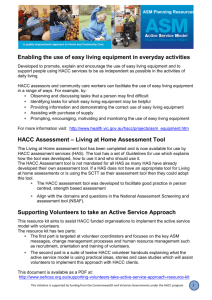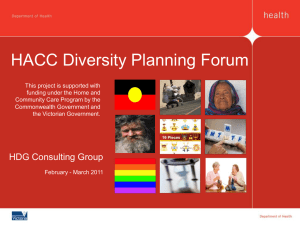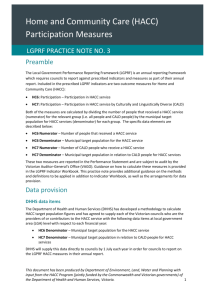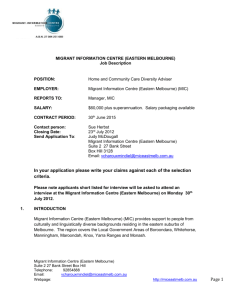HACC Diversity Priority Areas 2015-2016
advertisement
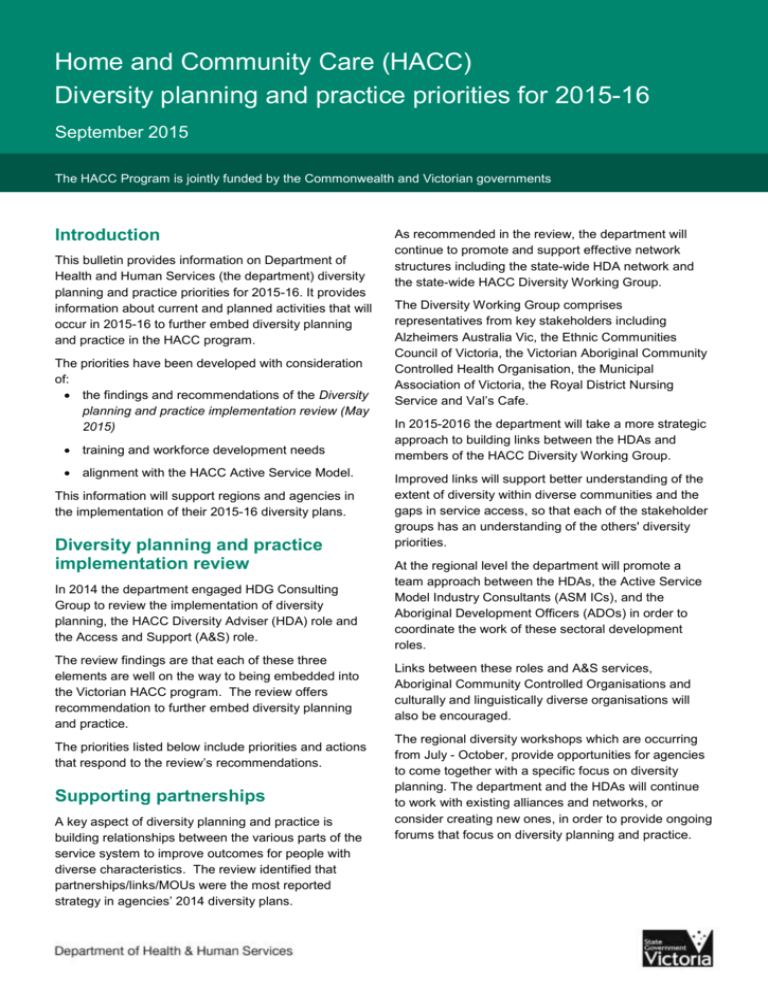
Home and Community Care (HACC) Diversity planning and practice priorities for 2015-16 September 2015 The HACC Program is jointly funded by the Commonwealth and Victorian governments Introduction This bulletin provides information on Department of Health and Human Services (the department) diversity planning and practice priorities for 2015-16. It provides information about current and planned activities that will occur in 2015-16 to further embed diversity planning and practice in the HACC program. The priorities have been developed with consideration of: the findings and recommendations of the Diversity planning and practice implementation review (May 2015) training and workforce development needs alignment with the HACC Active Service Model. This information will support regions and agencies in the implementation of their 2015-16 diversity plans. Diversity planning and practice implementation review In 2014 the department engaged HDG Consulting Group to review the implementation of diversity planning, the HACC Diversity Adviser (HDA) role and the Access and Support (A&S) role. The review findings are that each of these three elements are well on the way to being embedded into the Victorian HACC program. The review offers recommendation to further embed diversity planning and practice. The priorities listed below include priorities and actions that respond to the review’s recommendations. Supporting partnerships A key aspect of diversity planning and practice is building relationships between the various parts of the service system to improve outcomes for people with diverse characteristics. The review identified that partnerships/links/MOUs were the most reported strategy in agencies’ 2014 diversity plans. As recommended in the review, the department will continue to promote and support effective network structures including the state-wide HDA network and the state-wide HACC Diversity Working Group. The Diversity Working Group comprises representatives from key stakeholders including Alzheimers Australia Vic, the Ethnic Communities Council of Victoria, the Victorian Aboriginal Community Controlled Health Organisation, the Municipal Association of Victoria, the Royal District Nursing Service and Val’s Cafe. In 2015-2016 the department will take a more strategic approach to building links between the HDAs and members of the HACC Diversity Working Group. Improved links will support better understanding of the extent of diversity within diverse communities and the gaps in service access, so that each of the stakeholder groups has an understanding of the others' diversity priorities. At the regional level the department will promote a team approach between the HDAs, the Active Service Model Industry Consultants (ASM ICs), and the Aboriginal Development Officers (ADOs) in order to coordinate the work of these sectoral development roles. Links between these roles and A&S services, Aboriginal Community Controlled Organisations and culturally and linguistically diverse organisations will also be encouraged. The regional diversity workshops which are occurring from July - October, provide opportunities for agencies to come together with a specific focus on diversity planning. The department and the HDAs will continue to work with existing alliances and networks, or consider creating new ones, in order to provide ongoing forums that focus on diversity planning and practice. Training and workforce development The review notes that staff training and professional development was the second highest strategy that agencies identified in their 2014 diversity plans. HDAs play an important role in identifying regional training and workforce development needs and will continue to connect agencies with relevant training opportunities. The Victorian HACC Education & Training Service, through its state-wide training calendar, will continue to deliver a range of diversity training that is responsive to workforce needs. Some of the courses scheduled and planned for delivery through this service include: Work effectively with culturally diverse clients and co-workers Lesbian, gay, bisexual transgender and intersex (LGBTI) awareness Building Aboriginal competence training. Implementation resources There are a range of resources to support diversity planning and the implementation of diversity practice which are available on the HACC website. These include: Strengthening diversity planning and practice: a guide for Victorian HACC services (DH 2011) Creating GLBTI inclusive HACC services (Val’s Café 2014) Strengthening assessment and care planning: dementia practice guidelines for HACC assessment services (DH 2012) A guide to services for people with dementia and their carers (DH 2012). The department will ensure HACC managers and relevant operational staff are aware of the resources, particularly new staff. HDAs will assist agencies to implement these resources on the ground. This may occur through forums, workshops or one-on-one discussions. Development of agency diversity plans Diversity planning is an evidence-based population planning process. Agencies need robust population data in a format that is easy to understand in order to develop their plans. To support better understanding and consistency of messaging about diversity planning within organisations, the department will develop power point presentations for HACC managers to present to their boards/councils and direct care staff. The department will also support HDAs to develop data skills so they are better equipped to support agencies. This will include support in utilising various data sources and tools to identify changing demographics, such as the new and emerging culturally and linguistically diverse communities. The review highlighted sector interest in how to measure the impact of diversity planning. The department and the HDAs will identify and disseminate information about existing evaluation tools and diversity standards at the agency level. Client pathways In July 2015 the department provided a bulletin to agencies on the alignment of ASM and diversity plans. Understanding the synergies between ASM and diversity planning and practice should result in improved access to services and improved service responsiveness for people with diverse needs. The Diversity Working Group will work with the HDAs and the ASM ICS to identify areas for improvement in client pathways through the service system for the special needs groups, particularly as it relates to intake, assessment and culturally appropriate service provision. In particular closer working relationships between A&S services and the wider HACC service system will support improved client outcomes. Access and Support Access and Support (A&S) services are well placed to understand barriers to accessing HACC services. They play an important role in working with the broader HACC service system to support improved outcomes for HACC eligible people with complex needs due to diversity. The review identified the need for closer working relationships between HACC assessment services (HAS) and A&S services. The department will lead a project in collaboration with Ethnic Communities Council Victoria and the Municipal Association Victoria, which will develop strategies to build closer working partnerships between A&S and HAS. For further information contact: Ruth Reading ruth.reading@dhhs.vic.gov.au; your regional PASA or HDA. 2
